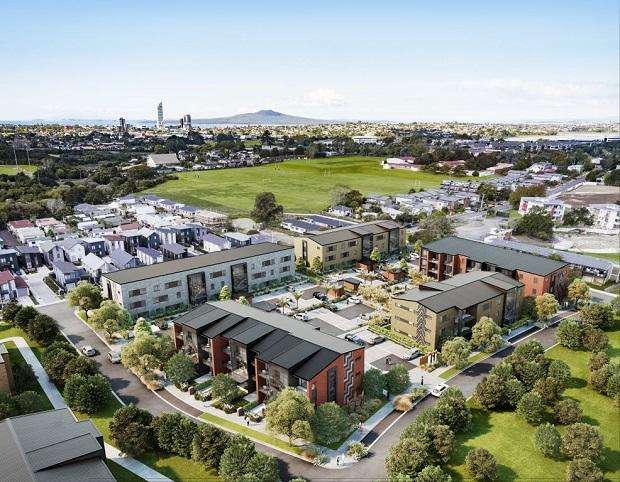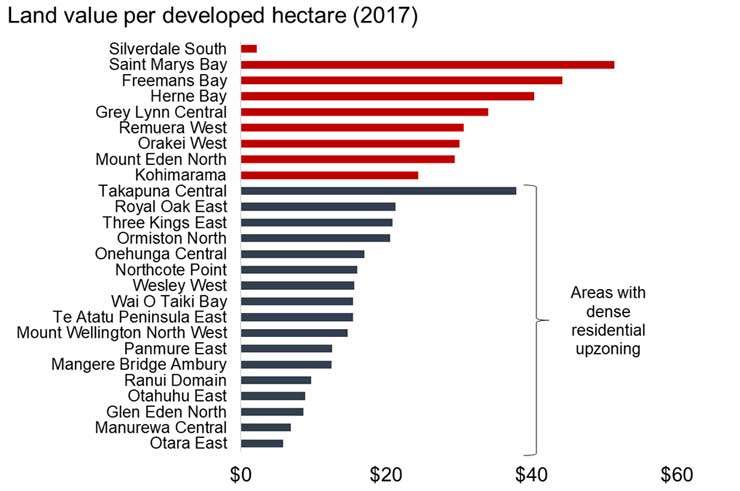Building consents in Auckland have risen 14% but that hasn’t resulted in a sudden influx of new homes, a new study has found.
The study, carried out by Auckland Council’s economists Shyamal Maharaj and Shane Martin, found that the growth in the year to February 2021 was fuelled by consents for apartments and townhouses in existing urban areas.
READ MORE: Find out if your suburb is rising or falling
A quarter of homes consented have still to be built, with take-up of the density allowed by the Auckland Unitary Plan mixed since the new planning rules came into effect.
Start your property search
“We found that within two years, just 75% of consented [homes] get built. Eventually the other 25% happen, but it takes time. A smaller development of, say, three townhouses, happens a lot faster than a 40-unit one,” says Martin.
“People see density is favourable, it comes with more goods and services and has the most amenities that make it desirable, but they’re apprehensive about it because it’s change.”
The study looked at suburbs with a high proportion of the highest density zoning for Town House and Apartment Buildings, allowed under the Auckland Unitary Plan. Martin and Maharaj say that while 68% of dwellings consented are in existing urban areas and over 60% of buildings consented are attached apartments, townhouses or units, development isn’t happening evenly across the city.
The math for developers, they say, is in the value of the land.

Developments in areas close to Auckland CBD, like this one in Northcote, are more advanced than other parts of Auckland. Photo / Supplied
“If land values are high, then higher density becomes more valuable. Developers also build more where their profit potential rises. This also explains why we have seen an increase in consenting activity as Auckland house prices have risen.”
The economists argue that land values in wealthy inner city suburbs like Remuera, Herne Bay and St Marys Bay – where the median property is well over $2 million – would be even higher than they current are if they had more streets zoned for higher density housing.
“Land that is allowed to have density is worth more than land without density zoning,” Martin says, adding that the most valuable land closest to the city centre is zoned THAB.
The research suggests that the most valuable streets in Remuera and Herne Bay are those ones that are zoned for higher density. “When only a handful [of streets] have got THAB then it’s incredibly valuable compared to suburbs where the whole place has that zoning.”

The council's research looked at land values in suburbs zoned for density and those that aren't. Table / Auckland Council
In Remuera, THAB zoning can be found along much of Remuera Road around Remuera Village, and parts of Armadale Road, Norana Avenue, Raukura Lane, St Vincent Avenue, Cotter Avenue and Ascot Avenue, while in Herne Bay THAB applies to just a few blocks on Jervois Road and Shelly Beach Road.
The economists found that Glen Innes has the biggest uplift in attached dwellings, helped by the public-sector led Tamaki Regeneration Project, where nearly a one square kilometre is zoned for more housing. Suburbs like Otahuhu, Glen Eden, Te Atatu Peninsula and Northcote have also seen an increase, Martin says, because they are reasonably close to the city but still with a lot of density allowed.
He says some of the greatest increases have been in Takapuna, where land value per square metre is roughly double some of the other suburbs and there are a lot of streets with the high density zones. On the other hand, inner ring suburbs like Point Chevalier have a lot of streets that allow medium density (mixed housing urban or suburban) but very little THAB.
“They are all reasonably close to the city centre, especially compared to say, Silverdale. They have dense zoning and good public transport and/or motorway access.”
Suburbs like Manurewa, Mangere, Panmure and Ranui have less density, which Martin and Maharaj call missed opportunities, as they are close to jobs and have lower land values that might have encouraged developers.
“Developers will go into areas that they think they can sell first, so those areas get picked off first,” says Martin.
Several of the suburbs with potential don’t quite yet have the shops and amenities that come with more people, but “people don’t live in building consents”.
“The jury is still out on how much [additional dwellings] will change the amenities offered in the city beyond the much-needed housing it is helping to deliver,” they say.


